Valley Of Flowers National Park : A Blooming Himalayan Paradise
Published on July 18, 2025
Valley of flowers tour package, Nestled high in the sweep of Uttarakhand’s Garhwal Himalayas, the Valley of Flowers National Park is a kaleidoscope of alpine flowers, misty meadows, and grand Himalayan peaks. Recognised as a UNESCO World Heritage site, it’s a dream destination for trekkers, nature lovers, photographers, and couples seeking mountain splendour.
Why Visit the Valley of Flowers?
During monsoon and early autumn, this lush valley transforms into a riot of color—blue, pink, yellow, and purple flowers dance across the meadows. Snow-fed streams, hidden waterfalls, and aromatic herb patches add to the charm. The experience of walking through this vibrant alpine garden—framed by towering peaks—is nothing short of magical.
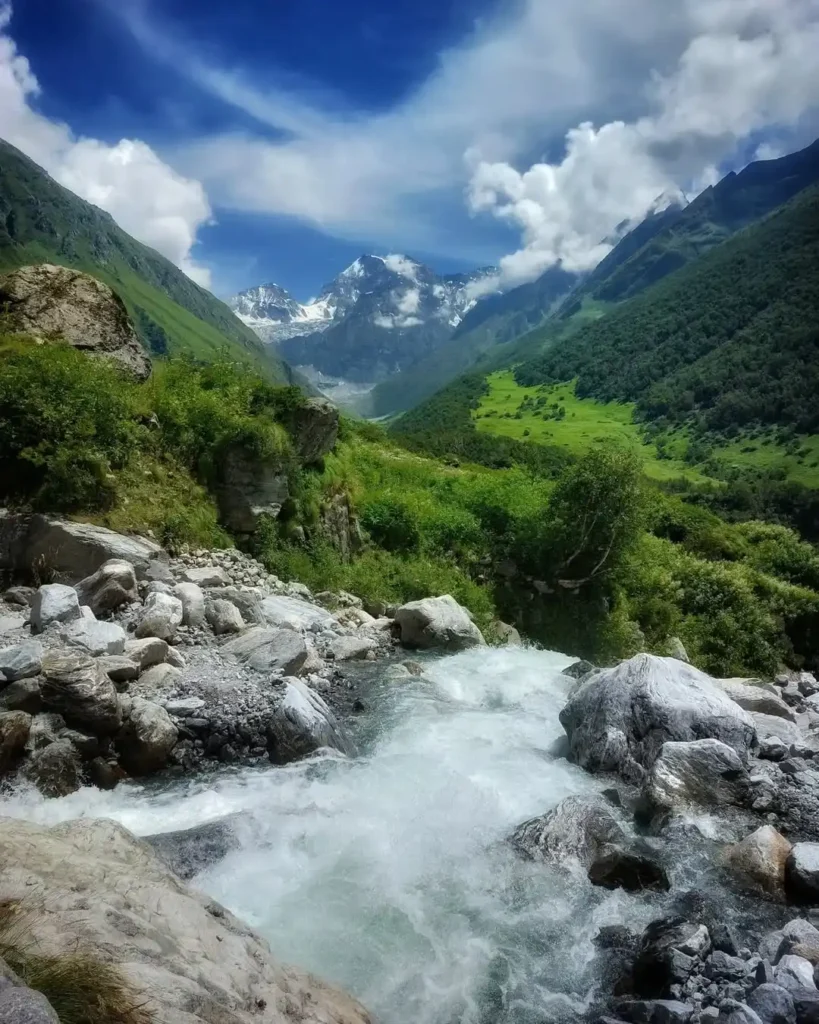
Into the Bloom: A Step-by-Step Journey through the Valley of Flowers
DAY 1: Depart from Rishikesh
- Upon reaching Rishikesh, head to 60's cafe ( The Beatles ), the starting point of your scenic journey to Govindghat / Pipalkoti.
- Enjoy breathtaking views of mountains and valleys en route.
- Check in to your accommodation and stay overnight.
DAY 2: Trek from Govindghat / Pipalkoti to Ghangaria
- Today, begin your 9km trek to Ghangaria, a peacful village nestles amidst forests and mountains.
- Enjoy the fresh mountain air and scenic views along the way.
- Upon arrival, check into your camp and explore the serene surroundings.
DAY 3: Trek from Ghangaria to Valley of Flowers
- In the morning, begin the exciting trek to the famed valley of Flowers.The trail is steep and rocky, but the stunning views make it worth the effort.
- Spend time soaking in the beauty before returning to Ghangaria.
DAY 4: Trek from Ghangaria to Hemkund Sahib
- Wake up early for the challenging trek to Hemkund sahib, with a steep ascent where a trekking stick is helpful.
- Enjoy views of snow-capped peaks and the pristine Hemkund lake.
- Spot the rare Bramhakamal flowers near the gurdwara, spend some peacful moments, and then return to Ghangaria for an ovenrnight stay.
DAY 5: Downhill Trek from Ghangaria to Govindghat / Pipalkoti
- In the morning, you will be starting the easy descent to Govindghat on the same trail that you trekked on earlier.
- After travelling through the same trail and witnessing the attractions and beauty from a different perspective, you will reach Govindghat.
- Upon reaching, settle into your Accommodation for an overnight stay.
DAY 6: Transfer to Rishikesh
- Begin your day by returning back to Rishikesh.
- As you reach rishikesh, your valley of Flowers Trekking package ends here, take a bundle of unbelievable memories with you.
Inclusions:
- Transportation from Rishikesh to Rishikesh.
- 2 Nights stay in Govindghat / Pipalkoti.
- 3 Nights stay in Ghangaria.
- 10 Meals - 5 Breakfasts & 5 Dinners (Veg).
- Toll Tax & Parking.
- Local exploration as per the itinerary.
- Experienced Trip Captain throughout the trip.
Exlusions:
- Any personal expenses ( laundry, shopping, tips, snacks, etc ).
- Any adventure activities not mentioned (e.g.,snow rides , skiing, etc.)
- Anything not mentioned in the itinerary.
- Hot water availability (not guaranteed in remote areas).
- Any kind of entry tickets of forests fees.
- Meals/Drinks other than those mentioned in inclusions.
- 5% GST (Goods and Services Tax).
- Travel insurance
- 4*4 vehicle charges for snow rides (if required during heavy snow)
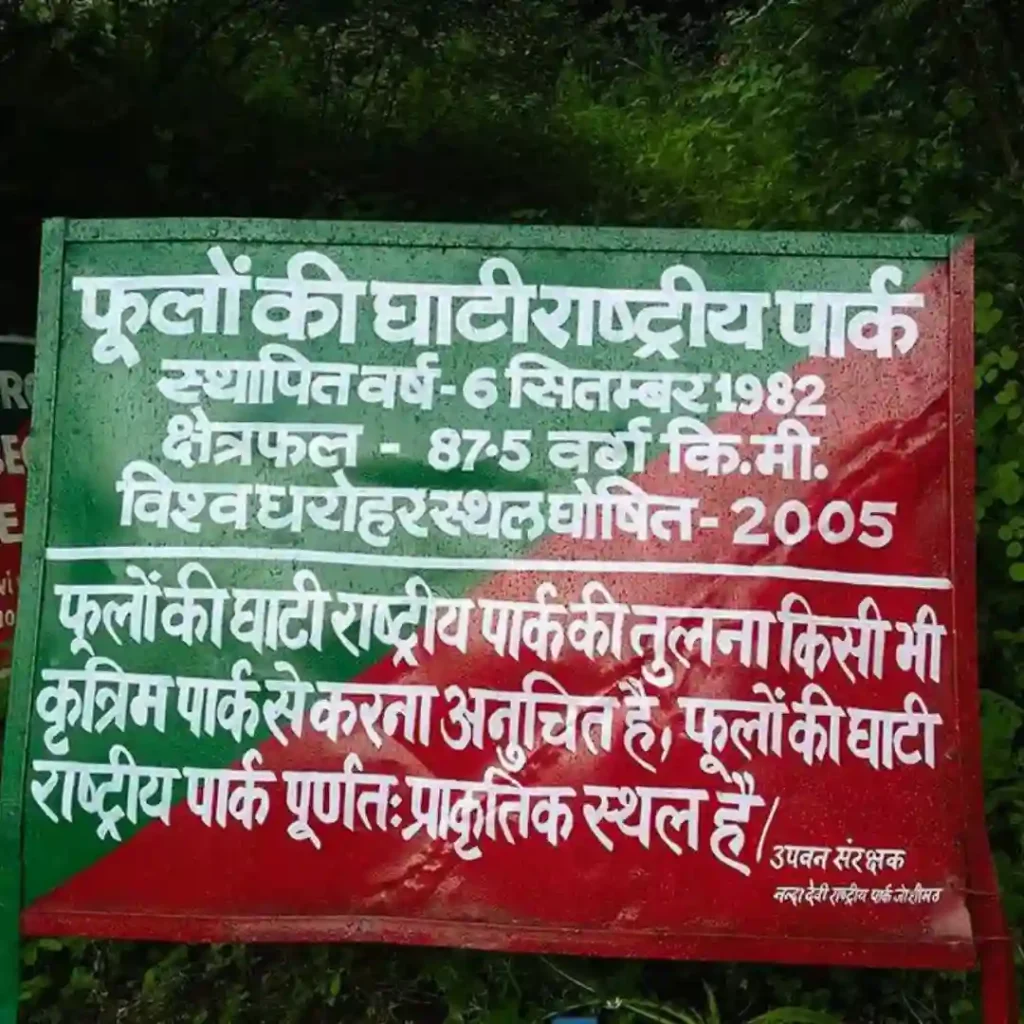
Valley of Flowers Tour Packages
Explore curated options designed for all types of travelers:
1. Valley of Flowers Tour Package from Delhi / Mumbai / Rishikesh / Haridwar
Packages typically include round-trip transport, stay in base towns or camps, meals, trek guidance, and permits. Variants include:
-
Valley of Flowers tour package for couple: cozy stay and romantic meadows.
-
Group departures or fixed departures for hassle‑free planning.
-
Price varies by season and accommodation style.
2. Valley of Flowers Trek Package / Guided Tours
-
Expert guides help you spot rare flora and explain the region’s ecology.
-
Valley of Flowers trek packages can be customized: from budget to premium.
-
Valley of Flowers guided tours are ideal for families, senior travelers, and solo hikers.
Package Highlights & Price Range
-
Budget options start around ₹7,000–₹10,000 per person.
-
Couple packages offer shared tents or rooms; meals and permits included.
-
Luxury upgrades with hot meals, deluxe stays in Ghangaria, and scenic pickups are also available.
Ask about our Valley of Flowers tour package from Delhi, from Mumbai, from Rishikesh, or package from Haridwar depending on your starting point.
How to Reach Valley of Flowers
-
Base Town: Zarwani/Joshimath.
-
From Rishikesh: ~310 km (~10–12 hours drive).
-
From Haridwar or Delhi: Well-connected by road via Rishikesh–Joshimath.
Once in Joshimath, the valley is accessed via Ghangaria—reachable by a trek or helicopter—and from there to the alpine meadows of the park.
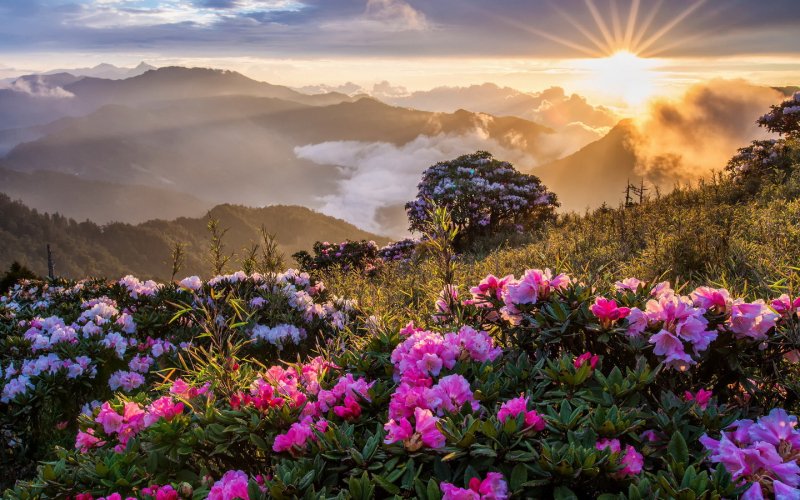
Trek Details: Valley of Flowers Trek Distance
-
Total Trek Distance: ~17 km round-trip from Ghangaria.
-
Trek Grade: Easy to moderate.
-
Walking Time: 6–7 hours on the way in; 4–5 hours return, depending on pace and stops.
The terrain is gentle, with rolling hills and mild elevation gain, making the trek accessible even for first-timers.
Why Choose a Tour Package?
-
All permits handled
-
Transport, accommodation, trek guidance included
-
Specialized Valley of Flowers tour packages with different options: couple packages, guided walks, fixed‑departure groups
-
Transparent pricing: Valley of Flowers tour package price fits a range of budgets
Petals in the Mist: Weather Wonders of the Valley of Flowers
Tucked high in the Garhwal Himalayas, Valley of Flowers National Park dances to the rhythms of nature. The weather here isn't just a climate—it's part of the adventure. From snow-covered silence to monsoon-fed miracles, each season paints the valley in a different light.
Summer (May to June) opens the gateway to this floral paradise. As the snow melts and trails clear, temperatures range between 10°C to 20°C, making it the perfect time to trek comfortably. The skies are clear, and the crisp mountain air carries the scent of blooming beginnings.
Monsoon (July to September) is the star of the show. This is when the valley transforms into a kaleidoscope of over 600 species of flowers. Expect light to moderate rain, misty paths, and vibrant blooms at every step. Daytime temperatures hover between 8°C to 17°C, while evenings remain cool and damp. Carrying rain gear is a must, but the dramatic beauty makes every drop worth it.
Post-monsoon (Late September to early October) marks the winding down of the bloom season. The weather becomes chilly, especially at night, and the valley begins to prepare for its winter slumber. It’s a quieter, more introspective time to visit—ideal for those who love golden meadows and fewer crowds.
Winter (Late October to April) blankets the entire valley in snow, closing off access completely. Trekking routes vanish under snowdrifts, and the flowers wait patiently beneath for spring’s warmth.
So, when planning your Valley of Flowers tour package from Delhi or anywhere else, aim between mid-July to early September for the best weather and full bloom experience. Whether you're coming on a Valley of Flowers guided tour or a couple’s escape, timing the weather right makes all the difference.
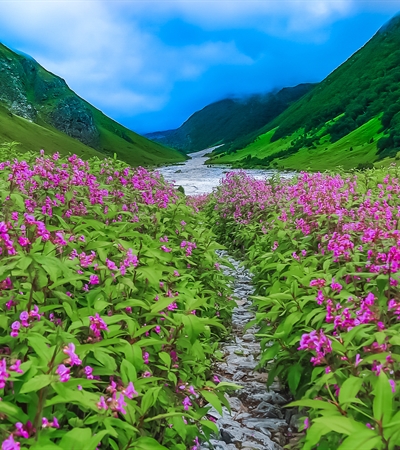
Resting Near the Bloom: Where to Stay Around Valley of Flowers
While the Valley of Flowers National Park itself is a protected UNESCO World Heritage site with no commercial development inside, the villages surrounding the park offer cozy, scenic, and authentic Himalayan accommodations that make your stay memorable and comfortable.
Ghangaria – The Gateway Village
Located about 4 km before the main valley entrance, Ghangaria is the final stop for trekkers and the base camp for all who visit the Valley of Flowers. This charming village is lined with small lodges, guesthouses, homestays, and a few government-run rest houses. Accommodations here are basic but warm, providing just what you need after a long hike—hot food, clean bedding, and heartfelt hospitality.
-
Popular stays in Ghangaria: GMVN Guest House, Himalayan Lodge, Hotel Kuber Annex, and various budget homestays.
-
Ideal for: Trekkers, families, couples, and spiritual seekers.
-
Average cost: ₹800 – ₹2000 per night, depending on season and facilities.
Govindghat – Comfortable Start to the Journey
Govindghat, located at the confluence of the Alaknanda and Lakshman Ganga rivers, is the starting point of the trek. This town has more varied and comfortable hotels where travelers usually spend a night before beginning the trek to Ghangaria.
-
Top picks in Govindghat: Hotel Bhagat, Badrinath Inn, and various GMVN properties.
-
Good for: Early risers looking to start the trek fresh or those returning from the valley.
-
Budget range: ₹1000 – ₹3000 per night.
Camping Options for the Adventurous
While camping inside the valley is not allowed, many adventure operators offer tented accommodations in and around Ghangaria. These semi-permanent setups come with sleeping bags, food services, and sometimes even bonfires under the stars.
-
Ideal for: Nature lovers, trekking groups, and offbeat explorers.
-
Available through: Valley of Flowers trekking packages or pre-booked adventure tours.
Couple-Friendly Stays with a View
If you’re booking a Valley of Flowers tour package for couples, look for boutique-style homestays with balcony views, private dinners, and romantic Himalayan settings in Ghangaria or Govindghat.
-
Romantic tip: Time your visit in peak bloom (late July to mid-August) and choose a homestay with valley-facing views for the ultimate Himalayan escape.
Spiritual & Budget-Friendly Lodges
Pilgrims and solo travelers often opt for budget dharamshalas or simple guesthouses that offer both affordability and a serene atmosphere. You’ll find these in Govindghat, Ghangaria, and nearby hamlets.
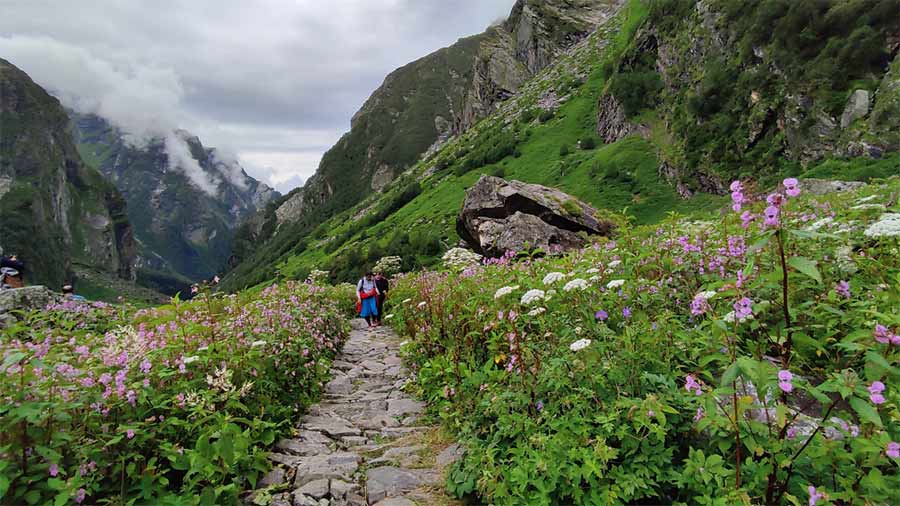
Where Earth Meets the Sky: Unique Wonders of Valley of Flowers National Park
Tucked away in the Garhwal Himalayas of Uttarakhand, the Valley of Flowers National Park is not just a destination—it’s a living painting, a sanctuary of color, fragrance, and rare natural magic. Beyond its breathtaking beauty, this UNESCO World Heritage Site holds several special features that make it a one-of-a-kind high-altitude paradise in India.
A Natural Floral Carpet Stretching Across the Himalayas
One of the most striking features of this national park is its vast meadows that burst into bloom during the monsoon months. More than 500 species of alpine flowers—including blue poppies, cobra lilies, primulas, orchids, and Brahma Kamal—bloom here in waves, transforming the valley into a mosaic of color.
-
Why it’s special: Nowhere else in India do so many rare Himalayan species grow together so abundantly in a single stretch.
A UNESCO World Heritage Site
In 2005, UNESCO recognized the Valley of Flowers as a World Heritage Site for its extraordinary ecological significance. It forms part of the larger Nanda Devi Biosphere Reserve, offering protection to countless plant, bird, and animal species that thrive in this fragile alpine ecosystem.
-
Unique distinction: It’s one of the few UNESCO sites dedicated solely to flora.
A Biodiversity Hotspot for Rare Wildlife
Though often overlooked, the Valley is also home to a diverse range of fauna, including endangered species like the snow leopard, blue sheep, Asiatic black bear, musk deer, and Himalayan monal (the state bird of Uttarakhand). The natural camouflage of these animals in such colorful surroundings makes every sighting feel magical.
-
Why it matters: The park is part of one of the last untouched high-altitude habitats for several rare and protected species.
High-Altitude Trekking Without the Extremes
At around 3,500 to 3,800 meters, the Valley of Flowers trek offers a gentle gradient, making it perfect for beginners and nature lovers alike. Unlike rough Himalayan expeditions, this trail is more about soaking in the beauty than battling the climb—making it popular among families, solo travelers, couples, and first-time trekkers.
-
Special feature: A trek that feels like a spiritual walk through heaven—without the harsh demands of altitude sickness or extreme climbing.
Close Proximity to Spiritual Treks: Hemkund Sahib & Badrinath
Not far from the Valley lies Hemkund Sahib, a revered Sikh pilgrimage site nestled at over 4,300 meters. Its crystal-clear glacial lake and tranquil setting make it a popular extension for those trekking to Valley of Flowers. Further ahead, Badrinath Temple, one of the Char Dham shrines, is also nearby.
-
Why it’s unique: A rare destination where spiritual paths and floral trails cross seamlessly.
Seasonal Bloom – A Timed Spectacle
The bloom here doesn’t last year-round. The best time to visit Valley of Flowers is from mid-July to late August, when the flowers are in full bloom. This limited window creates a sense of urgency and magic—you’re witnessing something that exists for only a few weeks each year.
-
Magical touch: The valley feels like a “living calendar” of nature—blink, and it’s gone for the year.
Silence, Solitude & Serenity in Every Step
Perhaps the most unforgettable feature of the Valley of Flowers is its sense of silence. There are no hotels inside the park, no honking vehicles, and no crowds chattering. It’s just you, the mountain air, and a sea of blossoms whispering in the wind.
-
Spiritual vibe: Ideal for meditation, photography, or simply resetting your soul away from screens and city noise.
TourMyHoliday Recommends:
Explore the park through curated Valley of Flowers trek packages, which include transport, stays in Ghangaria, meals, and guided access. Whether you choose a Valley of Flowers tour package from Delhi, Rishikesh, or Haridwar, we help you experience these unique features in the most seamless, safe, and soul-satisfying way.
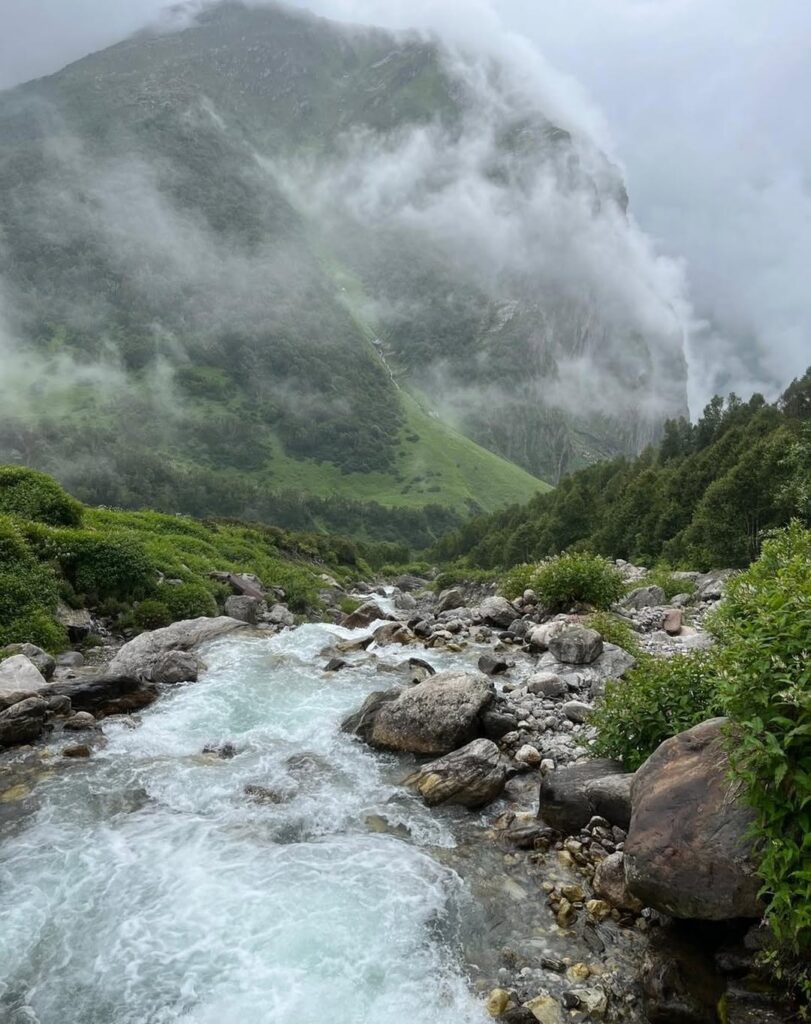
Sacred Petals: The Cultural Significance & Mystical Legends of Valley of Flowers
While the Valley of Flowers is famed for its unmatched natural beauty, its soul lies deep in the spiritual and cultural fabric of Uttarakhand. Revered by locals and pilgrims alike, this Himalayan valley is not just a trekking destination—it’s a living legend, woven with ancient myths, divine presence, and sacred energies.
The Myth of Hanuman and the Sanjeevani Booti
One of the most powerful and widely believed legends associated with the Valley is found in the pages of the Ramayana. It is said that when Lord Lakshman was wounded during the battle in Lanka, Hanuman was sent to bring the life-saving herb Sanjeevani Booti from the Himalayas.
According to local lore, this very valley is believed to be the place where Hanuman found the magical herbs. In his haste, Hanuman is said to have uprooted an entire mountain, and the flowers that sprang forth here are believed to be a blessing of divine energy.
-
Cultural insight: Many locals believe the Valley still holds healing powers, and that no flower from here should be plucked out of respect for its divine origin.
Spiritual Gateway to Hemkund Sahib
Just a short trek from the Valley of Flowers lies the holy Sikh pilgrimage site, Hemkund Sahib. This glacial lake and gurudwara, sitting at over 4,300 meters, is believed to be the place where Guru Gobind Singh Ji meditated in a previous life. Pilgrims on this path often visit both Hemkund Sahib and the Valley together, merging spiritual devotion with natural exploration.
-
Local belief: The blooming of flowers in the Valley each year is considered symbolic of purity and divine renewal, much like the spiritual rebirth found through meditation and pilgrimage.
A Tapobhumi (Land of Meditation)
Locals refer to the Valley as a "Tapobhumi", or land of penance and meditation. Many rishis and sages are believed to have meditated in this valley centuries ago, drawn by the peaceful silence, the intoxicating fragrance of wildflowers, and the cosmic connection one feels in such untouched nature.
-
Mystical energy: Visitors often speak of a profound calm and serenity here—one that can’t be explained, only felt.
A Place Where Nature Is Worshipped
In the villages around Govindghat and Ghangaria, the local people have a deep respect for nature. The valley is seen not just as a tourist attraction, but as a sacred living entity. Many even believe the flowers themselves have souls and should not be picked or trampled.
-
Tradition: During festivals, villagers offer prayers and light incense facing the valley, thanking nature for its seasonal gift of beauty and abundance.
Symbol of Feminine Energy and Creation
With its bursting flora, gentle streams, and ever-changing color palette, the Valley is often seen as a manifestation of Shakti, the feminine divine force in Hinduism. Local women especially see the Valley as a representation of motherhood, creativity, and rebirth.
Beyond the Trek: A Journey Through Myth and Meaning
Whether you're following in the footsteps of Hanuman, visiting nearby sacred sites, or simply soaking in the silence, the Valley of Flowers is more than a trek—it’s a pilgrimage of the spirit. These stories and beliefs breathe life into every petal, reminding us that nature and divinity are forever intertwined in the Himalayas.
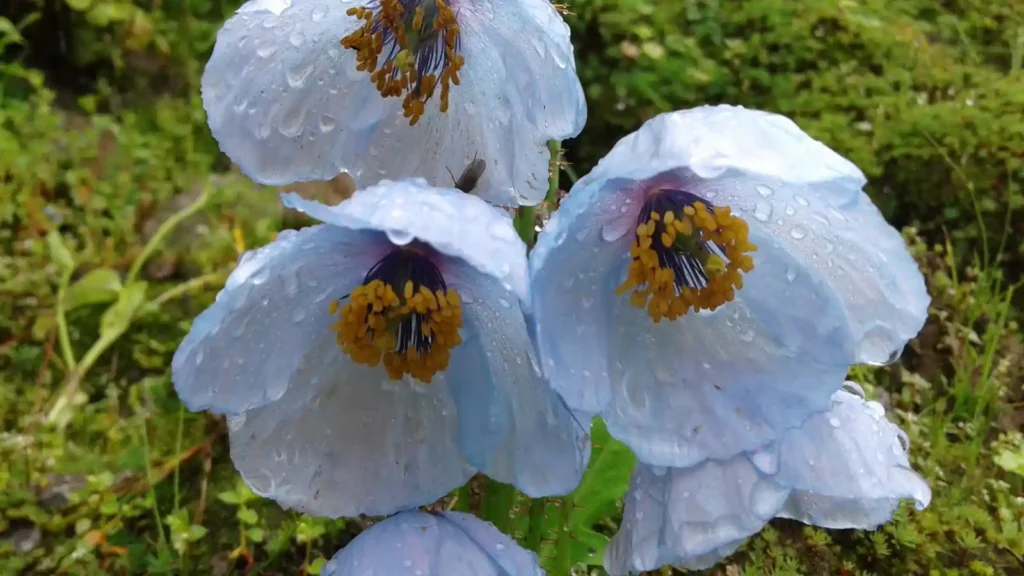
Between Petals and Peaks: Understanding the Difficulty of the Valley of Flowers Trek
The Valley of Flowers trek in Uttarakhand is one of those rare Himalayan journeys that balances natural beauty with manageable challenge. While it’s not the most difficult trail in the Garhwal region, it does demand a certain level of fitness, mental readiness, and respect for altitude.
Moderate but Rewarding – Ideal for First-Timers with Preparation
The trek is classified as easy to moderate, making it an excellent choice for beginners, families, and photography enthusiasts. The trail is well-marked, relatively wide, and doesn’t require technical climbing. However, don’t let the flower-filled imagery fool you—you’ll still be trekking at high altitudes.
-
Valley of Flowers trek distance: Approx. 38–40 km round trip, depending on detours (e.g., Hemkund Sahib).
-
Max altitude: Valley of Flowers sits at around 3,658 meters (12,000 ft).
-
Hemkund Sahib (optional extension): Climbs up to 4,329 meters (14,200 ft)—a steep, strenuous ascent.
Daily Challenges to Expect
-
Day 1 (Govindghat to Ghangaria): The 9–10 km climb can feel long, especially if you’re not used to walking uphill for several hours. It’s a steady incline, and you may experience fatigue.
-
Day 2 (Ghangaria to Valley of Flowers): This is where the magic happens. The trail is undulating, and although less steep than Day 1, narrow rocky paths and possible slippery patches after rain demand attention.
-
Optional Day 3 (Ghangaria to Hemkund Sahib): A challenging uphill climb on a stone-paved trail with steep gradient and thinner oxygen. Highly recommended only for those with decent stamina and prior trekking experience.
Altitude – The Silent Climber
While there’s no snow or extreme weather in peak season, altitude sickness can affect trekkers above 3,000 meters. Acclimatization, hydration, and avoiding alcohol or heavy food are key to staying comfortable.
Who Can Do This Trek?
-
Fitness Level: You should be able to walk 8–10 km daily over 4–6 hours.
-
Age Range: Trekkers from 10 to 60+ have completed this trail with proper pacing.
-
Experience: Prior trekking experience is helpful but not mandatory if you're moderately fit.
Trekker’s Tip: Go Slow, Go Smart
-
Start your trek early in the morning to avoid weather changes.
-
Use trekking poles to support knees on uneven terrain.
-
Wear good-quality hiking shoes with grip.
-
Don’t push yourself too hard—rest, hydrate, and enjoy the journey.
Tough Enough to Be Memorable, Gentle Enough to Be Enjoyable
The Valley of Flowers trek is a beautiful balance—challenging enough to give you a sense of achievement, yet accessible enough to open the gates of the Himalayas to new adventurers. It's not a race; it’s a journey through myths, mountains, and a million blossoms.
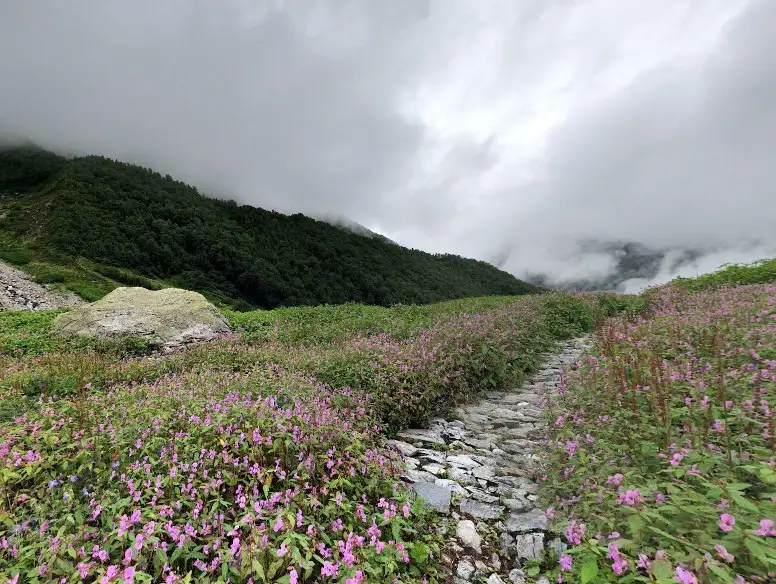
The Last Bloom: Why the Valley of Flowers Stays with You Forever
As your boots find their way back down the trails and the misty silhouettes of the Himalayas fade into memory, the Valley of Flowers trek leaves behind more than photographs—it leaves you with a changed heart.
You arrived searching for beauty, but you leave having experienced serenity, silence, and strength. Whether it was the gentle challenge of the trek, the cultural whispers of the legends, or the sheer explosion of colors across the valley floor, every step gave you something more than just a view—it gave you a story.
At TourMyHoliday, we don’t just plan treks—we curate soulful escapes. Our Valley of Flowers tour packages from Delhi, Rishikesh, Haridwar, and even Mumbai are crafted for couples, families, and explorers who want more than a vacation—they want to feel alive in nature's embrace.
So whenever the routine gets loud and life feels grey, remember: there’s a valley that still blooms for you.
Let us take you there
Frequently Asked Questions:
1. What is the best time to visit Valley of Flowers?
Mid-July to early September is ideal—this is when the valley is in full bloom, offering a breathtaking floral spectacle.
2. How difficult is the Valley of Flowers trek?
It’s a moderate trek—perfect for beginners with decent fitness. The path is well-defined but includes steep sections.
3. How far is the Valley of Flowers trek distance?
The total trek is about 17 km round-trip from Ghangaria to the core of the valley.
4. How do I reach Valley of Flowers from Delhi?
Take a bus/train to Haridwar or Rishikesh, then drive to Govindghat. Trek starts from there.
5. What is the distance from Rishikesh to Valley of Flowers?
It's around 270 km by road to Govindghat, followed by a short drive to Pulna and then the trek begins.
6. Can I book a Valley of Flowers tour package from Delhi?
Yes! TourMyHoliday offers all-inclusive packages from Delhi, Haridwar, Rishikesh, and Mumbai.
7. Are there good accommodation options near Valley of Flowers?
Yes, Ghangaria offers simple lodges, guesthouses, and tents—comfortable enough for trekkers.
8. Is Valley of Flowers in Kashmir or Uttarakhand?
The famous Valley of Flowers National Park is in Uttarakhand. A different valley by the same name exists in Kashmir.
9. Can couples join Valley of Flowers tour packages?
Absolutely! We offer special Valley of Flowers tour packages for couples—blending adventure with romance.
10. Are guided tours available for Valley of Flowers?
Yes, guided tours and fixed departures are available through Tour My Holiday for a worry-free experience.
.jpg)

.jpg)
